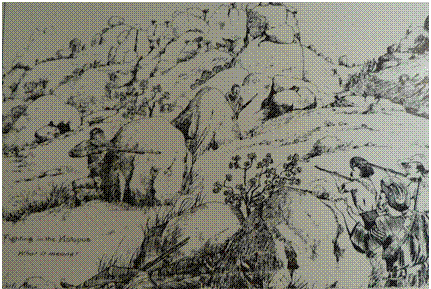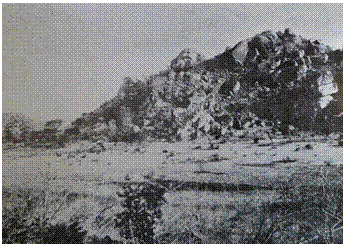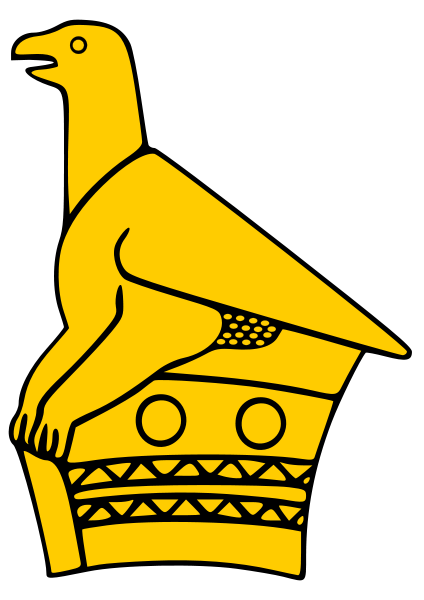Pioneer Days
On to the Matobo!
Plumer's victory at Ntaba-zika-Mambo removed the threat to Bulawayo from the north; the shortness of the campaign and the relative ease with which it was ended gave the military a surplus of confidence that any fighting in the Matobo Hills would be in the nature of a mopping up operation; the focus was rapidly shifting to Mashonaland. It was clear that new men to the scene – Carrington and Plumer – failed to understand the nature of the terrain they were about to tackle. Weston Jarvis could have advised them better: “A ghastly country for fighting... Huge granite kopjes full of caves... Many of the coves [men] who know tell me that it is just about the most difficult country in the world – worse than Afghanistan or Chitral. I would say that it would not be easy to find a more beastly place to fight in” (quoted in Ranger 1967: 182).
Who was where?
Over 10,000 warriors as well as families of the fighters were manning defences in the hills. They were divided into impis of various strengths, commanded by shrewd and capable men, most of whom had been blooded in the war of 1893 and the skirmishes of April and May. Babyaan and Dhliso occupied the central portion, based on the important hill of Nkantola which commanded a main entrance to the hills. Nyanda, Sikombo and Umlugulu commanded the right wing which stretched to the east to where the Tuli River crossed the Umzingwane. To the left (west) Mabiza and Hole controlled the area around Inungu, Efifi and Kalanyoni, all of which can be seen from Malindidzimu. Carrington has 1100 white soldiers and 160 Cape Boys as well as 100 black levies, raised by Johan Colenbrander, supported by a motley crew of “friendlies”. Carrington split his forces into two: Plumer taking 800 whites and the Cape Boys to the area near Reps school and Tyrie Laing a flying column of 200 men into the eastern Figtree area.
What was the plan?
Carrington aimed to end the war quickly. The size and ruggedness of the Matobo Hills made Plumer's encircling tactics unsuitable and he could not hope to outflank any of the Matabele forces. Plumer devised a new plan, one threatening the main concentration of non-combatants at Nkantola, thus hoping to draw out Babyaan and Dhliso into a large set-piece battle that automatic weapons would win for the whites. Plumer led his men directly south while Laing was sent in a supporting operation to storm Inungu and meet up with Plumer cutting off the retreat of any Matabele soliders. If the plan worked, Plumer would have punched a hole though the Matabele lines that they could not repair and they would either be forced to surrender or could be winkled from their mountain strongholds by siege or storm.
When did this happen?
By July 19 Plumer was ready and repeating his belief in the efficacy of night marches, led his men from Fort Usher at 2230, making for the hills. The men rested once they reached the head of the Tuli gorge and dawn showed them an unforgiving landscape of wild kopjes infested with enemy soldiers. Their scout was the indefatigable Baden-Powell who soon found a large force of Matabele soldiers, “one dense brown mass, with their assegai blades glinting sharply in the rays of the morning sun. We soon got the guns up to the front of the gorge and in a few minutes they were banging their shells with beautiful accuracy over the startled rebel camp” (Baden-Powell 1897: 148). BP led in the contingent of black troops once the Matabele were adjudged suitably softened up, leaving the white soldiers as spectators. Plumer spent the better part of his day “anxiously expecting news of Laing's force” having heard artillery fire early in the morning; it could only be bad news (Plumer 1897: 158).
Inside a Matobo Stronghold

Fighting in the Matopos (What it Means) From Baden-Powell (1897)
Baden-Powell (1897: 149) has left us a graphic description:
... all the paths were blocked and barricaded with rocks and small trees; the whole place was honeycombed with caves to which all entrances, save one or two, were blocked with stones, among these loopholes were left, such as to enable the occupants to fire in almost any direction.
Robertson's Cape Boys took the brunt of the fighting again and after facing difficulties in the Tokwe Gorge, managed to get themselves out with a few casualties, notably one white NCO killed and ten wounded. Sykes (1897: 172) was uncomplimentary about the black soldiers, claiming they “completely lost their heads and fired their rifles off wildly as fast as they could load without any definite object. They were a useless rabble, as well as a considerable source of danger to those near them”. The Matabele gave as good as they got and after the battle, Sykes (1897: 174) reveals a grudging admiration: “That selfsame 'eathen had commenced to learn a thing or two, and showed every sign of putting his knowledge to practical use”. The Matabele were fast learning the correct tactics for warfare involving firearms, even repeating orders given by white commanders to their own men (Sykes 1897: 175).
What happened to Laing?

The Column advancing towards Inungu
Laing (1897: 280), commander of the Belingwe Field Force, had been ordered to “advance on Inugu, with orders to attack at daybreak on the 20th and turn rebel impi out of their positions, and then proceed to cut off the retreat of the rebels from the Cheleli valley and join Colonel Plumer's column by that route, if possible”. He had 170 mounted whites and 300 “friendlies” at his disposal which slowed his march down the valley somewhat. Late on the 19th his forces emerged into a vlei which was closed off to the west by the bulk of Mt. Inungu and the other side by a long, wooded ridge. He knew enemy forces were in the area and it was not beyond the bounds of possibility that Laing's men could be attacked and wiped out; in fact Laing (1897: 283) mentions making a bet of “saxpence” with the troop's Dr. Anderson that an attack in the area was certain. Thus it is surprising that he chose to form the laager against the flank of a high ridge instead of the middle of the vlei; the former provided a high degree of cover to enemy troops too close for comfort. Laing was not a complete fool however; “Every precaution was taken to guard against a surprise, and I believe every man present expected an attack” (Laing 1897: 283). Halkett (1971) confirms this assumption.
Sourced from the Zanj Financial Network 'Zfn', Harare, Zimbabwe, email briefing dated ? 2011


 South Devon Sound Radio
South Devon Sound Radio Museum of hp Calculators
Museum of hp Calculators Apollo Flight Journal
Apollo Flight Journal Apollo Lunar Surface Journal
Apollo Lunar Surface Journal Cloudy Nights Classic Telescopes
Cloudy Nights Classic Telescopes The Savanna - Saffer Shops in London
The Savanna - Saffer Shops in London Linux Mint
Linux Mint Movement for Democratic Change
Movement for Democratic Change